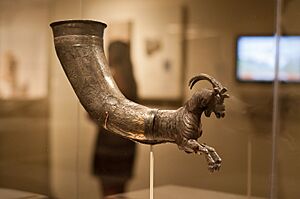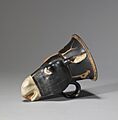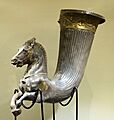Rhyton facts for kids
A rhyton (pronounced RYE-ton) is a special container, usually shaped like a cone. People used rhytons to drink liquids or to pour them out during ceremonies, like offerings to gods. They were also used just for drinking at meals.
Many rhytons look like an animal's head. These cool vessels were made in many parts of ancient Eurasia, especially from Iran to the Balkans. Some rhytons have a hole at the bottom, letting the liquid flow out. Others were simply drinking cups, but they couldn't stand upright without spilling!
The word rhyton comes from an ancient Greek word meaning "to flow." Rhytons with a cone shape have been known in the Aegean region since the Bronze Age, which was about 4,000 years ago. They are similar to, and might have come from, drinking horns. Rhytons have been used across Eurasia since very old times.
Contents
What Is a Rhyton and How Was It Used?
The word rhyton comes from the Greek word rhein, which means "to flow." This makes sense because many rhytons were designed to pour liquids. Imagine a vessel with a wide opening at the top and a small hole at the bottom.
People would scoop wine or water from a large container. Then, they would hold the rhyton up, unblock the small hole with their thumb, and let the liquid flow into their mouth. Sometimes, the liquid was poured onto the ground as an offering to gods. This is similar to how people drink from a wineskin today.
In ancient times, rhytons were sometimes called keras, meaning "horn," because they looked like drinking horns. The oldest form of Greek, called Mycenaean Greek, didn't use the word rhyton. But they did have vessels shaped like bull's heads, which were similar. These were called ke-ra-a, meaning "horned."


Rhytons shaped like bulls were filled through the large opening and emptied through the smaller one. This often needed two hands: one to cover the small hole and one to fill the rhyton. Some experts think two people might have been needed to fill them, or a chain or rope was used. When a rhyton shaped like an animal was filled, it looked like the animal was drinking! A bull rhyton weighed about 3 kilograms (6.6 pounds) when empty and up to 6 kilograms (13.2 pounds) when full.
Other animal-themed rhytons were shaped like boars, lions, and lionesses. Some, like the lioness rhyta, could be filled by simply dipping them into liquid. Rhytons that were designed to be held horizontally, like the lioness ones, could be filled by being lowered into a liquid and supported. But vertical ones, like the boar rhyta, needed someone to cover the main opening to stop liquid from spilling while it was filled.
Rhytons were often used to strain liquids such as wine, beer, and oil. Some were even used in blood rituals or animal sacrifices. In these cases, blood might have been mixed with wine. Sometimes, the vessel was shaped like the animal used in the ritual, but not always.
Where Were Rhytons Found?
It's not certain if every ancient drinking horn or pouring vessel had a hole at the bottom. The idea of scooping liquid probably came first. But once holes were added, artists started shaping the vessels like animal heads. Liquids would then pour from the animals' mouths! These animal heads included cows, horses, deer, and even dogs.
Rhytons have been found in many ancient civilizations across the Near and Middle East, including Iran, dating back to 2000 BC. They are often shaped like animal heads or horns and can be very fancy, decorated with precious metals and jewels. In Minoan Crete, silver and gold bull's head rhytons were very common. They had round openings for wine, which would pour out of the bull's mouth. Several of these have been found in ancient palaces.
One of the oldest examples of an animal figure holding a cone-shaped vessel was found in Susa, in southwestern Iran. It's a silver statue from about 3000 BC, showing a cow with a woman's body. She is holding the vessel between her hooves.
Rhytons were very popular in ancient Persia, where they were called takuk. After the Greeks won a battle against Persia, they brought back many treasures, including rhytons. Greek artists then started making their own versions of these Persian rhytons. Not all rhytons were valuable; many were simple cone-shaped cups made of ceramic.
Rhytons in Greek Stories
In ancient Greek art, especially on red-figured vases, you often see scenes from mythology. A common theme shows satyrs (mythical creatures, half-human, half-goat) with rhytons and wineskins. Satyrs were known for their love of fun and wine.
The connection between satyrs, wine, and rhytons is mentioned in an ancient Greek poem called Dionysiaca. It describes satyrs at the first grape crushing, when the god Dionysus invented wine-making: "...the fruit bubbled out red juice with white foam. They scooped it up with oxhorns, instead of cups which had not yet been seen, so that ever after the cup of mixed wine took this divine name of 'Winehorn'."
This story links the rhyton (the "winehorn") to the very beginning of wine. It suggests that the rhyton was seen as a container for the "substance of life," celebrated through dancing and rituals.
Images for kids
-
A silver rhyton from the Achaemenid Empire, found at Erebuni Fortress.
-
A ceramic ceremonial rhyton shaped like a grape cluster, from Alişar Hüyük in Anatolia, Middle Bronze Age, 1750–1650 BC.
-
A boar's head rhyton from Ugarit, shown from the bottom.
-
An Ancient Greek rhyton shaped like a dog's head, made by Brygos in the early 5th century BC. It's at the Jérôme Carcopino Museum in Aleria.
See also
 In Spanish: Ritón para niños
In Spanish: Ritón para niños
















